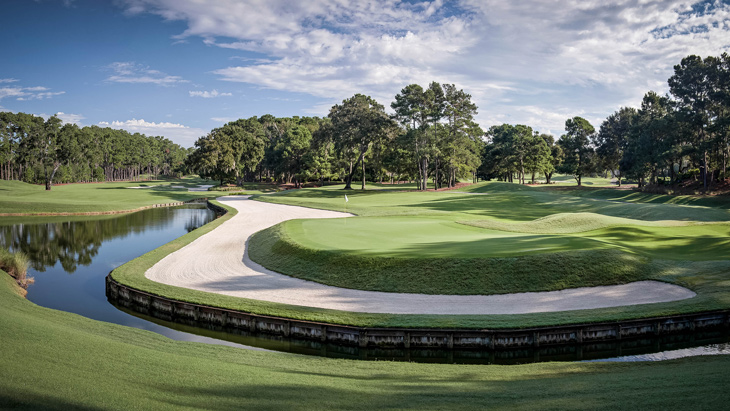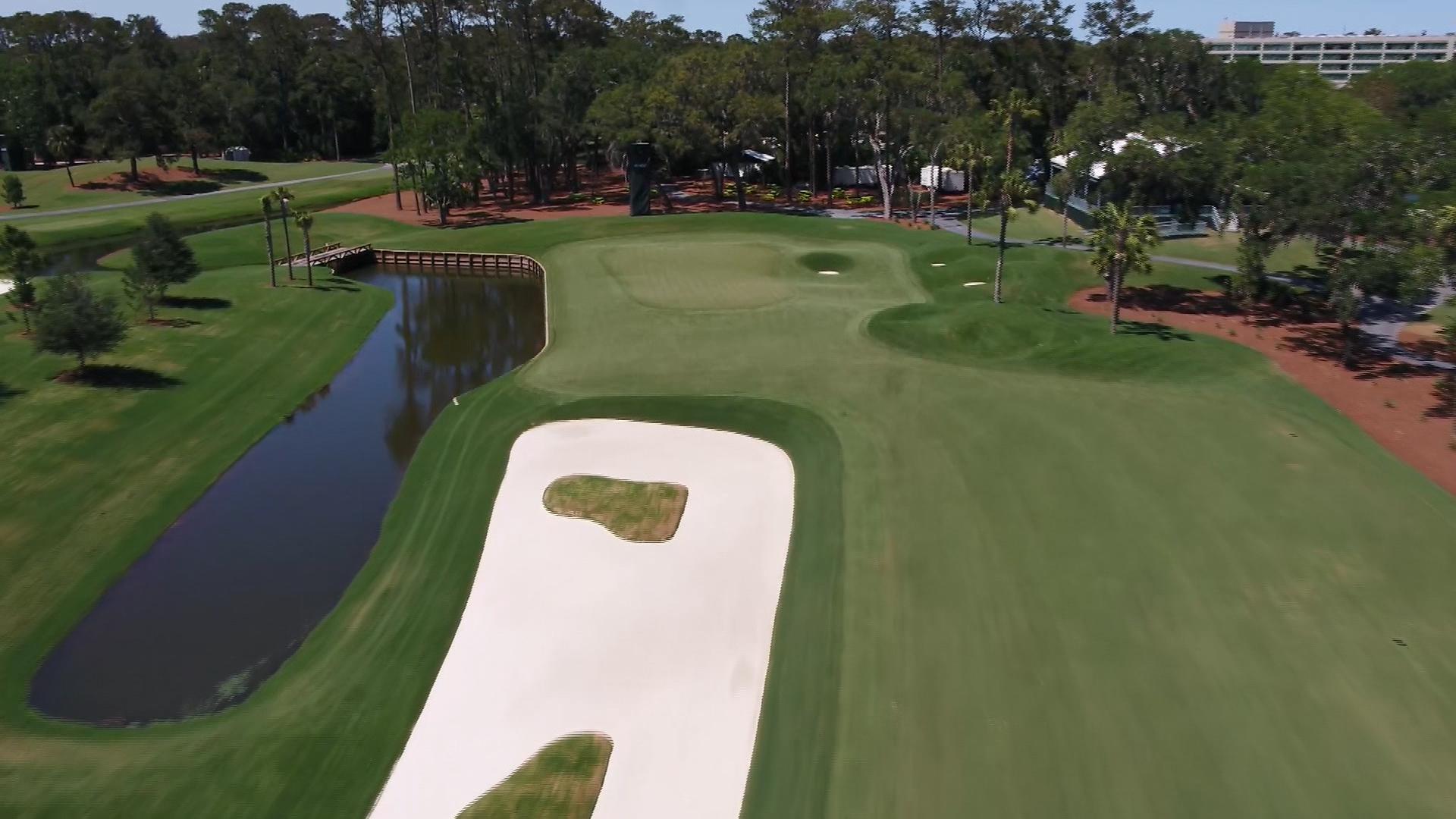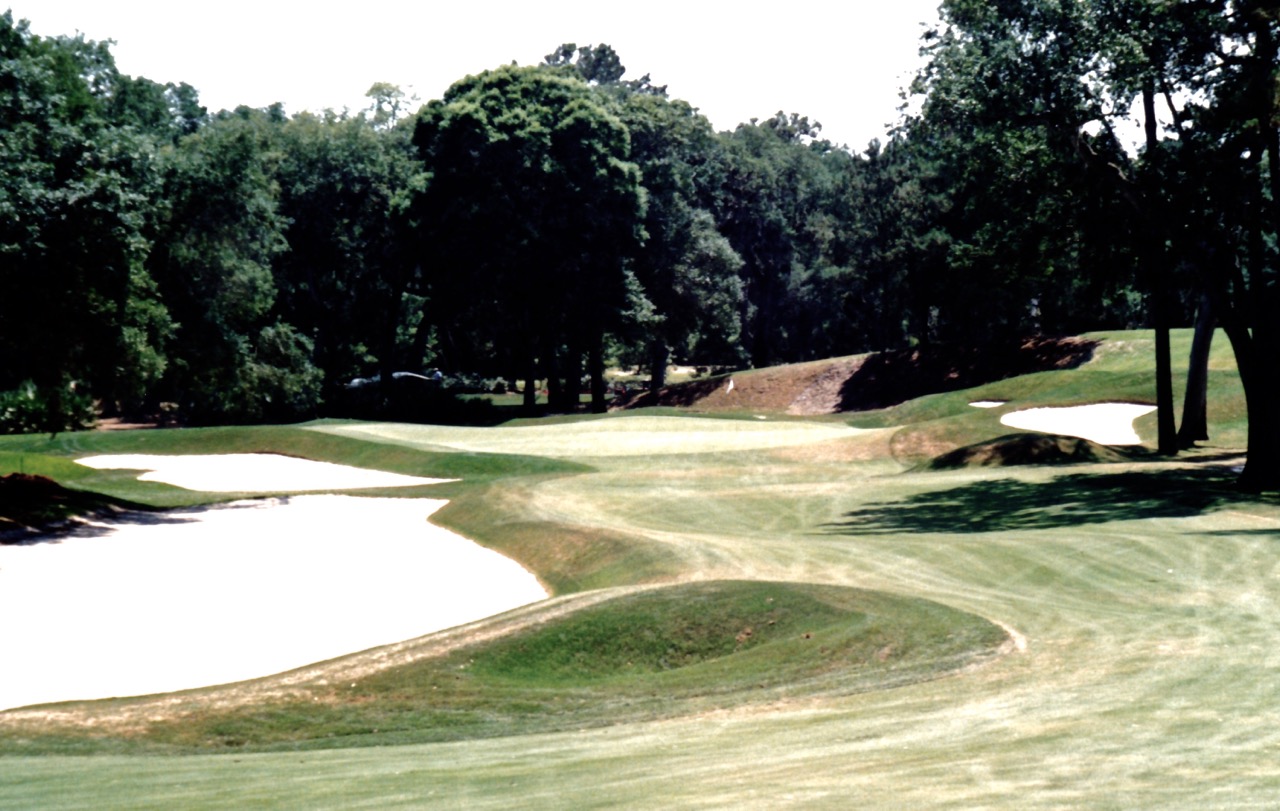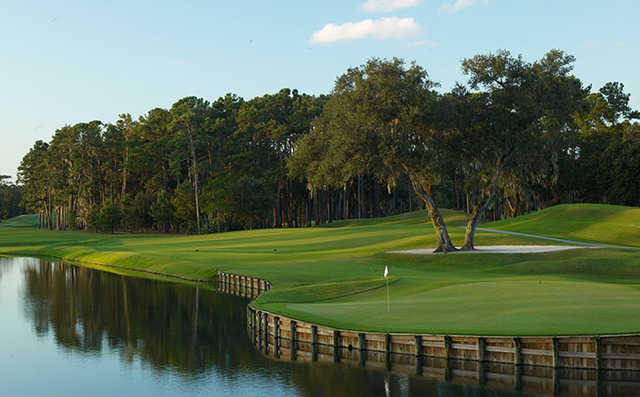Masterpiece Theater–TPC Sawgrass Stadium Course

A favorite debate among golf architecture students and historians is about what courses constitute the most influential in the evolution of golf design.
Most groupings would include St. Andrews, National Golf Links of America, Pine Valley, Augusta National, and Sand Hills. The PLAYERS Stadium Course at TPC Sawgrass is often cited as another construction and cultural landmark. For better or worse (depending to whom you speak), it’s hard to visualize the path of American design, from the early 1980’s until now, without Pete Dye’s TPC.
The Stadium Course didn’t so much change the direction of architecture as strap on a solid rocket booster and launch it into space. If Sand Hills was a stripped down repudiation of virtually every bloated cliché golf design had ingested the previous 50 years — including most of Dye’s own work — the Stadium Course unapologetically celebrated those elements (it’s with no small amount of irony to note that Bill Coore, a protégé of Dye who speaks of him with the warmest affection, has never built anything that looks like a Dye course).
It was in this black Ponte Vedra swamp that Dye demonstrated once and for all how to place a chokehold the public’s imagination using every conceivable (and some previously un-conceived) device. The paying public and audiences viewing The Players Championship reacted lustfully, cheering on the course’s wickedness and lack of subtlety, while architects observing from docks afar soon saw the TPC as a glowing green beacon exhorting them to begin humping in the extremes.

One measure of its impact is to consider how many imitators the TPC (and its first cousin PGA West) spawned, though its legacy is unfairly tarnished by that ignominy. The message the Stadium Course effectively did drive home was that it was possible to muscle a powerful, strategic, world class golf course into a flat, wet, atrocious property, thereby endowing developers everywhere with renewed license to aggressively package real estate and golf together in the very worst possible places.
It also synthesized in one grand venue the forms and design ideas Dye had been developing and refining over the previous decade. The stadium seating concept was novel, but the TPC wasn’t anything revolutionary design-wise — Dye had been working most of these tropes for years. Here, however, he was able to implement them on the largest, brightest stage to date.

For all Dye’s great and influential work before and since, his career would be viewed in an entirely different context without the Stadium Course, his seminal creation. Think of Scorsese without Raging Bull, Michael Jackson without Thriller, or Pynchon with no Gravity’s Rainbow. The legacies would exist, but it’s not possible to be legendary without a masterpiece. And in cases like these, the masterpiece creates the artist as much as the artist creates the masterpiece.
But none of this quite explains what makes the Stadium Course a masterpiece.
The transformation of a borderline malarial swamp into a singular, worldwide golf phenomenon is inarguably impressive. But as golf, the TPC is pure guts and glory, a visual and psychological gymnasium featuring 18 sharp, distinct pieces of apparatus. Each hole demands the execution of specific skills, and the opportunity to succeed or fail — to remain aloft or tumble, hard –is a breathless constant often determined by a matter of degrees.

Though some of Dye’s feature shaping has been inspired by links courses, we’re a long way from Scotland here and there’s very little open-endedness to the TPC. Depending on the pin settings there’s typically a correct and incorrect way to approach each hole.
It sets up like a liquified algebraic equation where shots are played to exact positions that unlock the next set of integers. It’s not enough to simply draw or fade the ball according to the set-up: distance control is equally important because it’s so easy to drift into a hazard, a poor angle or an awkward lie; miss the ideal spot and prepare to face some real mathematical slapstick. I know of few other courses where the prescribed exactitude gives as much sense of reward.
Understanding the tactical aspects only gets us halfway through the totality of the composition. The routing is also brilliant with holes placed in ever-switching directions that confront the player with endless arrangements of obstacles, colors, shades, vegetation and movements. The atmosphere is thick with visceral stimuli.

Tim Liddy, who has worked for and with Dye since the early 1990’s, has described the TPC like a layer cake built on the basis of horizontal planes: first the surface of water, upon that flat waste bunkers, the elevated levels of fairway and rough next, then the greens, then backdrop lines. In between are vertical elements like wooden bulkheads and steep bunker faces. Through it all the property no longer feels flat.
As with Augusta National, most casual viewers feel like they know all the holes even if they’ve never visited, but you can’t understand the surfaces, the swells of ground or the requisite degrees of precision it demands without playing it.
The 1st hole seems basic but the slight angle of the elevated green over the fronting bunker and the raised rear portion make playing from the right side of the fairway an absolute must, especially to rear pins.
I could never get tired of the short par-4 4th — the already nervy little tee shot is exacerbated by the knowledge that second shots played from the rough (or the long strip bunker down the right) have no chance of landing with any amount of control on the shallow, sloping green set directly over a canal.
The big contours of the 8th green don’t show up on television, nor do the internal rolls and deep fallaway surrounds of the 9th green. The right-to-left 10th is an especially slinky, seductive par-4, and the long 14th is about as good as a strong two-shot hole can get. And I haven’t even mentioned the famous final trio.
The TPC occupies — proudly — a point far remote from old original fields of play and the naturalist volkgeist that dominates the discussion of exceptional architecture. But as a constructure with an emphatic do or die manifesto calling for attack, maneuvering and survival, its a reminder that golf can be many things, including gladiatorial and pure spectacle.
It says, yes, golf is indeed a sport, a game of action and skill, and this is one of its greatest arenas. (96)
[Note: the 12th hole was remodeled into a drivable par-4 with water to the left in 2017.]
Tournament Players Club Sawgrass—Stadium Course
Ponte Vedra/Jacksonville
Architect: Pete Dye
Year: 1981
